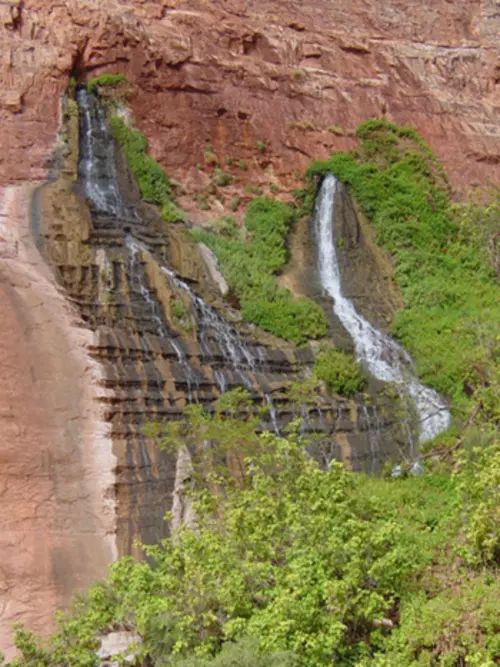
Vasey's Paradise in Grand Canyon National Park, Arizona, Kanab ambersnail habitat
On January 6, 2020, the U.S. Fish and Wildlife Service (FWS) published a proposed rule in the Federal Register announcing the agency’s finding that the Kanab ambersnail (Oxyloma haydeni kanabensis) is no longer warranted for listing as an endangered species under the federal Endangered Species Act (ESA). The proposed rule states that the Kanab ambersnail does not represent a valid taxonomic entity, and therefore does not meet the definition of “species” under the ESA. The ESA defines “species” as including ''any subspecies of fish or wildlife or plants, and any distinct population segment of any species of vertebrate fish or wildlife which interbreeds when mature.”
The Kanab ambersnail, which gets its name from its mottled, amber-colored shell, is a terrestrial snail in the Succineidae family. Typically found in marshes and other wetlands, the Kanab ambersnail often inhabits dead and decaying vegetation. Currently, three populations of Kanab ambersnail exist in Vasey’s Paradise and Upper Elves Canyon, Arizona, and Three Lakes, Utah.
The Kanab ambersnail first received ESA protection from an emergency listing in 1991 after a survey discovered that one of the snail’s two Utah populations was nearly extirpated, while the other population was subjected to major habitat alteration and destruction. Following a 5-year review of the species’ status in 2011, the FWS determined that threats to the Kanab ambersnail remained the same as when it was first listed. However, data from that review also indicated that the Kanab ambersnail might not be a distinct subspecies of the Oxyloma genus. A more comprehensive study of the species’ genetics followed, which the FWS considered in its proposed rule, along with “all available genetic information” on the Kanab ambersnail.
The proposed rule states that the best available scientific and commercial data indicated that the Kanab ambersnail is “not a valid subspecies,” thereby disqualifying it from ESA protection. The FWS stated that it reviewed an array of analyses that presented multiple different interpretations of the taxonomy of the Kanab ambersnail, all of which diverged from the FWS’s original listing. The FWS explained that traditional diagnostic methods such as nuclear and mitochondrial DNA testing, as well as shell morphology and reproductive anatomy analysis, were unsuccessful at distinguishing the Kanab ambersnail from other members of Oxyloma. The FWS cited various published and unpublished genetics reports supporting its conclusion, stating that “none of the genetic studies provides support for Oxyloma haydeni kanabensis as a valid subspecies.”
In its Federal Register notice for the proposed rule, the FWS states that the Kanab ambersnail’s larger taxonomic entity has not yet been identified, and so the FWS is unable to perform a status review of the genus or provide any evaluation of its population size. The notice further provides that the FWS “do[es] not consider the absence of information on the larger taxonomy of a group to be sufficient reason to keep an invalid subspecies listed” under the ESA. Because the Kanab ambersnail is not eligible for ESA protection, the FWS asserts, no post-delisting monitoring plan is necessary.
The agency’s proposed rule and supporting documents are available at regulations.gov, Docket Number FWS-R6-ES-2019-0055. The 60-day period for public comment on the proposed rule is currently set to end on March 6, 2020.
- Associate
Sam Savoni focuses her practice on a variety of environmental and land use matters, including those dealing with the Endangered Species Act, National Environmental Policy Act, Clean Water Act, National Historic Preservation Act ...
Nossaman’s Endangered Species Law & Policy blog focuses on news, events, and policies affecting endangered species issues in California and throughout the United States. Topics include listing and critical habitat decisions, conservation and recovery planning, inter-agency consultation, and related developments in law, policy, and science. We also inform readers about regulatory and legislative developments, as well as key court decisions.
Stay Connected
 RSS Feed
RSS Feed
Categories
- Alternative Energy
- Bald and Golden Eagle Protection Act
- Budget
- CEQA
- CESA
- Climate Change
- Congress
- Conservation
- Construction Projects
- Consultation
- Continuing Education
- Court Decisions
- Critical Habitat
- Delisting
- Endangered Species Act
- Event
- Fish & Wildlife Service
- Freedom of Information Act
- Government Administration
- Legal
- Legislation
- Listing
- Litigation
- Migratory Bird
- National Marine Fisheries Service
- NEPA
- Off Shore Wind
- Pacific Northwest
- project
- Publications
- Regulatory Reform
- Sacramento-San Joaquin Delta
- SEPA
- Speaking Engagements
- Supreme Court
- Texas
- Timberland
- Water Issues

